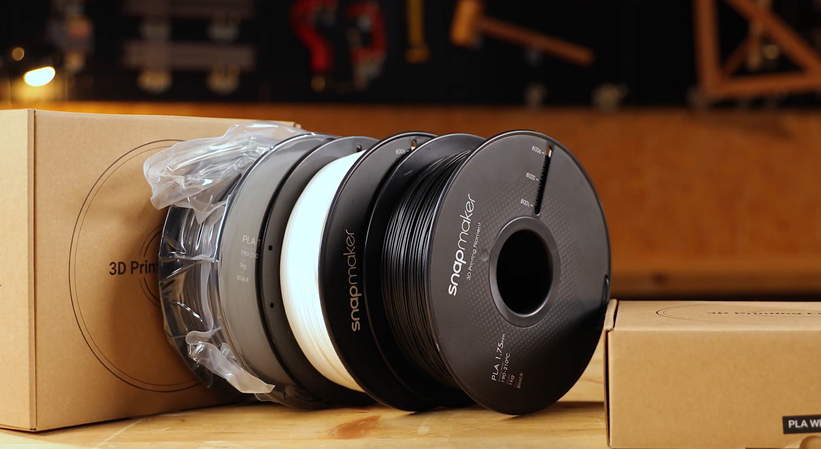
Creating Custom Filament Storage Solutions to Prevent Moisture Damage
Moisture absorption is a common issue for 3D printer filament, particularly hygroscopic materials like nylon, PETG, and even PLA, which can lead to print defects such as bubbling, stringing, or weak layer adhesion. For hobbyists and small-scale prototypers, maintaining filament quality is crucial to achieving consistent, high-quality prints. This guide provides a practical, step-by-step approach to designing and building custom filament storage solutions at home, using affordable materials to create sealed containers with desiccants, along with tips for monitoring humidity to ensure long-term filament integrity.
Why Proper Filament Storage Matters
Hygroscopic filaments absorb moisture from the air, which can degrade their mechanical properties and printability. When heated in the 3D printer’s hotend, absorbed water turns to steam, causing bubbles, inconsistent extrusion, or brittle prints. Proper storage prevents these issues, extends filament lifespan, and reduces waste, saving money and ensuring reliable results for prototyping projects. A DIY storage solution offers a cost-effective alternative to commercial filament dry boxes, tailored to your specific needs.
Step 1: Assessing Storage Needs
Before building a storage solution, evaluate your filament inventory and printing environment. Consider:
- Filament Types: Identify which filaments are most susceptible to moisture (e.g., nylon and PETG are more hygroscopic than PLA).
- Quantity: Estimate how many spools you need to store (e.g., 5–10 spools of 1 kg each is common for hobbyists).
- Space Constraints: Determine where you’ll store the containers (e.g., a shelf or closet) and measure available space.
- Printing Frequency: If you print frequently, consider a storage solution that allows filament to feed directly to the printer without opening the container.
A typical setup might store 5–10 spools in a single container, with provisions for desiccant and humidity monitoring, and optionally, a filament feed port for active printing.
Step 2: Choosing Materials for the Storage Container
Select materials that are airtight, durable, and easy to work with. Common options include:
- Plastic Storage Bins: Choose a clear or translucent bin (e.g., 20–30 liters) with a gasketed lid for an airtight seal. Ensure the bin is made of food-grade plastic to avoid chemical contamination.
- Sealing Mechanism: Use bins with snap-on or locking lids. Add a rubber or silicone gasket (available at hardware stores) to enhance the seal if needed.
- Desiccants: Silica gel packets (100–200 grams per 10 liters of container volume) are effective and reusable. Avoid loose silica beads to prevent contamination.
- Hygrometer: A small digital hygrometer (costing $5–$15) monitors internal humidity levels.
- Filament Feed Port (Optional): For active printing, use 3D-printed or store-bought PTFE tube couplers to create a sealed feed port.
For a budget-friendly setup, a 20-liter plastic bin with a gasketed lid, silica gel packets, and a hygrometer costs approximately $20–$30.
See also: Influence of Technology In Agriculture
Step 3: Building the Storage Solution
Follow these steps to create a custom filament storage container:
- Select the Container: Choose a bin large enough to hold your spools (e.g., 40 cm x 30 cm x 20 cm for 5–10 spools). Ensure it has a flat, sealable lid.
- Add a Gasket: If the bin lacks a gasket, apply a self-adhesive rubber or silicone gasket strip around the lid’s inner edge to ensure an airtight seal.
- Install a Hygrometer: Place a digital hygrometer inside the container to monitor humidity. Choose a model with a display visible through the clear bin or one that logs data.
- Add Desiccants: Place 200–400 grams of silica gel packets inside the container, distributed evenly (e.g., in mesh bags or small containers). Avoid direct contact with spools to prevent abrasion.
- Optional Feed Port: For active printing, drill a 5–10 mm hole in the side of the bin and insert a PTFE tube coupler (e.g., PC4-M6 or PC4-M10, commonly used in 3D printers). Seal the coupler with silicone sealant to maintain airtightness. Feed the filament through the tube to the printer, ensuring minimal exposure to air.
- Organize Spools: Use 3D-printed or foam spacers to keep spools upright and prevent tangling. Label each spool with its material type and date of storage.
Test the seal by closing the lid and pressing gently; a good seal will resist air escaping. Check the hygrometer after 24 hours—humidity should be below 15% for optimal filament storage.
Step 4: Monitoring and Maintaining Humidity
To ensure long-term filament quality:
- Check Hygrometer Regularly: Aim for humidity levels below 15%. If levels rise above 20%, replace or recharge the desiccant.
- Recharge Desiccants: Most silica gel packets can be reused by heating them in an oven at 100–120°C for 1–2 hours. Check for color-changing indicators (e.g., orange to green) to confirm readiness.
- Seal After Use: Open the container only when necessary, and reseal immediately after removing or adding filament to minimize moisture exposure.
- Dry Filament as Needed: If filament shows signs of moisture (e.g., popping sounds during printing), dry it in a food dehydrator or oven at 45–60°C for 4–6 hours before use.
Step 5: Testing Stored Filament
Before using stored filament for critical prototypes, print a test model, such as a 20 mm calibration cube or a thin-walled cylinder, to check for moisture-related issues:
- Bubbling or Popping: Indicates moisture. Dry the filament and check storage conditions.
- Stringing or Oozing: May result from moisture or incorrect settings. Adjust retraction (e.g., 1–2 mm distance, 30–40 mm/s speed) and dry the filament.
- Brittle Prints: Suggests severe moisture damage. Dry the filament and consider replacing it if quality doesn’t improve.
If the test print is successful, the storage solution is working effectively. Log humidity readings and test results to track performance over time.
Practical Tips for Success
- Start Small: Begin with one container for your most-used filaments (e.g., PLA and PETG) before scaling up.
- Label Everything: Mark containers with filament types and storage dates to avoid confusion.
- Use Clear Containers: Visibility helps you monitor spools and hygrometer readings without opening the container.
- Batch Dry Filament: Dry multiple spools at once in a dehydrator to save time before storage.
- Ventilate When Drying: Work in a well-ventilated area when drying filament to avoid inhaling fumes, especially for materials like ABS or nylon.
Benefits for 3D Printing
A custom filament storage solution ensures consistent print quality by preventing moisture-related defects, reducing failed prints by up to 80% for hygroscopic materials. It extends filament lifespan, saving $20–$50 per kg by avoiding premature degradation. For prototyping, reliable filament quality means stronger, more accurate parts, critical for functional testing or iterative designs.
Challenges and Solutions
Building an airtight storage solution can be challenging if the container or gasket is subpar. Test the seal by submerging the closed container in water (without filament) to check for bubbles. If leaks occur, reinforce the gasket with silicone sealant. Another issue is desiccant saturation; replace or recharge silica gel every 1–2 months, depending on humidity levels. For active printing setups, ensure the feed port remains sealed to prevent air ingress, using PTFE couplers with tight fittings.
Conclusion
Creating a custom filament storage solution is a practical, cost-effective way to protect 3D printing filament from moisture damage. By selecting the right materials, building an airtight container, and monitoring humidity with desiccants and a hygrometer, you can maintain filament quality for consistent, high-quality prints. Test stored filament regularly, refine your setup, and incorporate feed ports for active printing if needed. With this approach, you’ll ensure reliable filament performance, reduce waste, and enhance the success of your 3D printing projects, especially for small-scale prototyping.




